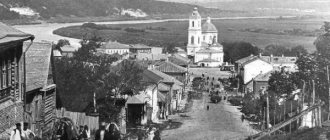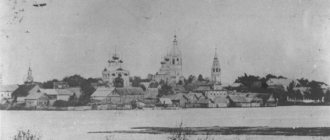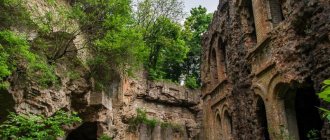Orsha is a small Belarusian city, located just 40 kilometers from the Russian border at the confluence of the wide Dnieper and picturesque Orshitsa. Known since 1067, at different times it was part of the Minsk and Polotsk principalities, belonged to the Grand Duchy of Lithuania, the Polish-Lithuanian Commonwealth, and the Russian Empire.
Places where two rivers merge are considered clean, protected from evil. The ancient Orsha residents, who founded the city, probably expected that in the event of military conflicts, the two rivers would become a natural barrier in the path of enemies. Unfortunately, the rivers did not save the city; the modern territory of Orsha more than once became an arena for military operations. During the Great Patriotic War of 1812, the city was occupied by French troops, and during the First World War, Orsha was occupied by the Germans. As a result of hostilities, the city was burned.
After the formation of the Soviet Union, Orsha was transferred to the Belarusian SSR in 1924.
Orsha is a quiet, provincial town, to which the republican authorities tried to give a tourist appearance by restoring the historical center, including the Jesuit college, putting the castle hill and church buildings in order.
Orsha railway station
The city of Orsha is a major railway junction. Trains pass through it to the largest cities in Europe and Russia. And for many guests, the station becomes the first attraction from which their acquaintance with the city begins.
The station was built at the beginning of the twentieth century, and resembled a fortress with narrow windows and tower columns, which can be seen in archival photographs. However, during the war the station building was badly damaged and after reconstruction it changed its appearance beyond recognition.
Location: Zaslonova street - 3a.
Orsha settlement
The city began with the Orsha settlement 900 years ago. Once upon a time there was a five-tower castle with a drawbridge. Only an empty hill has survived to this day, on which a stone stele was erected in honor of the founding of Orsha. The memorial sign is built in the form of a gate, on which is written the date of the first mention of the city in the Tale of Bygone Years - 1067.
There are many options for the origin of the name of the city of Orsha - these are guesses and legends and research by toponymists.
From hazel, which grew in abundance in these places, to the brown and even rusty color of the water in the Orshitsa River. It seems that a group of enthusiastic local historians managed to get to the bottom of the truth. During the expedition, it was found out that about a thousand years ago, it was not Slavic, but Finno-Ugric tribes that passed through and roamed here. They came from the distant Ural mountains and went further north. It was in their language that the root “Orsa” was found, which means “flowing water” or “water flowing in a river bed.”
In 1620 Orsha was given city self-government under Magdeburg law. On December 13, the coat of arms was granted: a golden crescent and a silver cross in a blue field, as well as a seal and permission to build a town hall with a clock. This was the first city of Orsha. The clock was probably placed on the tower of the Jesuit College.
After Orsha became part of the Russian Empire, in 1781 the city received a second coat of arms, and almost 200 years later, in 1971, another change of coat of arms occurred. In April 2002, by decision of the session of the Orsha City Council, the first coat of arms of 1620 was approved as the city’s coat of arms. If everything is clear with the symbolism of the last two coats of arms, then the symbolism on the first coat of arms has different interpretations. The well-known expert in Heraldry, the compiler of the collection “Heraldry of the Cities of Belarus” does not yet have an explanation of the coat of arms of Orsha, but there are several versions explaining the symbolism placed on the coat of arms of the city: the cross and crescent are often found in the heraldry of different countries, which symbolize the birth of Christ from the womb of the Virgin Mary. In turn, the crescent moon is considered the symbol of the Mother of God, and the cavalry cross is a symbol of demonstrated courage. Perhaps this is connected with some kind of battle, the winners of which could have been the people of Orsha, but this is only an assumption. On this score, the Belarusian local historian Pyotr Borodovsky has his own version of the origin of the Orsha coat of arms. He came across a description of the family of Count Morkov in the World Pathfinder magazine. And it turned out that the ancient ancestor of these counts was Count De Marco. We know that in the 16th century the Polish-Lithuanian Commonwealth had a young king who had no real power. With him and with the queen there was a spiritual mentor who was the representative of the Pope - this is Count De Marco. And so, this spiritual mentor, being in the rank of cardinal, taking into account the fact that the College of Jesuits was already built in Orsha and it was already practically an outpost, in order to somehow assert a certain territory for himself, he offered his coat of arms to the city Orshi - cross and crescent on a blue background. In order to give some more specific rights to the Polish-Lithuanian Commonwealth, Orsha received Magdeburg law in 1620. If we consider the full part of the coat of arms of the count's family, we can see that it consists of three parts, but the central part is precisely the image that has the first coat of arms of the city of Orsha. The second part is associated with Catholicism, it depicts a candle and a cardinal's hat. The third part is a saber and a ribbon, which says that there were major military leaders in this family. The knight's motto "A knight is nothing without a sword" is written at the bottom.
Jesuit College
The collegium building on one of the city squares attracts the eye with its beauty. At one time there was a school for noble children, then a local theater and even a prison. This all happened at the turn of the 17th and 18th centuries. There was also a dormitory for students from distant lands. In 1812, Napoleon's headquarters were located here for one day. Currently, the building houses a children's library, Gromyko's art gallery and exhibition halls. City fairs and various festivals are held here on the square.
Location: Lenin street - 6.
Leisure
Active recreation in Orsha can be varied. The most visited place among all establishments is the ice arena. Its building was put into operation recently. Here you can play billiards (3 USD) and bowling (10 USD for 1 hour), go ice skating, and visit the gym.
The arena also offers the following services (prices are in BYN):
- Fitness – 3.70.
- Individual training in the gym with an instructor – 6.
- Boxing classes – 2.
- Ice skating (adult ticket) – 4.
- Figure skating training – 9.50.
- Table tennis – 3.
- Tennis – 8.
You can get here by bus or taxi. The ice arena is located at st. Lenina 79. On the street. V. Belinsky 1 there is an establishment where you can play laser tag. The cost of the game for 2 hours is 4 USD, 3 hours – 5.5 USD. The ticket price includes everything you need for the game - camouflage and weapons. There is a discount system.
Children's Park "Fairytale Country"
With children you can visit the children's park “Fairytale Country” on the banks of the Dnieper. Here you can not only walk and breathe air, but also admire various sculptures of characters from Soviet cartoons. There is also a small children’s railway on the territory, on which kids can happily ride along the alleys of the park.
Location: K. Marx street.
How to get there
Orsha (sights are the main wealth of this city) is an important transport hub of the Republic of Belarus. This is where the paths of Russia and Ukraine intersect. Not only important highways but also railway lines pass through this city.
By train
Trains depart daily from Minsk to Orsha. The Belarusian Railway services this route, making the trip easy. Travel time from Minsk to Orsha will take 2 hours 25 minutes. Ticket prices start from 4.5 USD for a reserved seat, 11 USD for a compartment and 100 USD for a soft passenger. The cheapest ticket will cost 3 USD.
It is worth noting that various routes run through Orsha, and therefore the trains can be completely different. So, “Warsaw-Moscow”, “Brest-Moscow”, “Kaliningrad-Moscow” pass through this city. There is also a direct connection “Minsk-Orsha”.
By car
By car you can get to Orsha from Minsk along the M-1/E30 highway. Travel time is from 2 to 2.5 hours. In addition to personal vehicles, you can come to this city by minibus or bus.
They regularly travel here from different districts of Minsk:
- From the street Bobruiskaya, 6.
- From the street Kirova, 1.
- From Art. Borisovsky Trakt metro station.
Ticket prices start from 3 USD. Road transport, as well as railway transport, can pass through Orsha, as well as a direct route.
Museum complex "Mlyn"
In the center of the city, in the building of a mill built at the beginning of the twentieth century, there is an ethnographic museum. It has two halls. One is dedicated to agricultural topics. It tells how the Belarusians cultivated the land, and you can see the devices for processing the crops.
The second hall displays products made by national craftsmen of the past period. There are weaving products and household items here. There is also an exhibition hall where products of modern masters are presented.
Location: Zamkovaya street - 2.
Church of the Nativity of the Virgin Mary
At the moment, the Church of the Nativity of the Virgin Mary is a new temple, erected in place of a previously destroyed temple during Soviet times in the 60s of the 20th century. But in style it completely repeats the old temple. Its white and blue colors harmonize beautifully with the waters of the Dnieper, on the banks of which this church is located.
You can also visit the Cathedral of St. Michael the Archangel, which is located nearby. It was built in the 1990s from wood.
Location: Sovetskaya street - 4A.
Church of St. Joseph
From the outside, the Church of St. Joseph does not stand out much in its architecture. An ordinary three-story building, like a recreation center. You can pass by without even realizing that this is a church. And, by the way, at one time the House of Culture was located there. However, it is currently a functioning Dominican church. And its history begins in 1808.
Location: Sovetskaya street - 6.
Population
Belarus is an international country.
Therefore, Orsha is home to the following nationalities:
| Nationality | Population | In percentages |
| Tatars | 46 | 0,04 |
| Lithuanians | 36 | 0,03 |
| Jews | 269 | 0,23 |
| Armenians | 103 | 0,09 |
| Gypsies | 35 | 0,03 |
| Poles | 255 | 0,22 |
| Ukrainians | 1112 | 0,95 |
| Azerbaijanis | 49 | 0,04 |
The majority of the population belongs to Belarusians. They make up 86.96%, which is equal to 101934 thousand people. These data refer to the 2009 census. This procedure is repeated in 2022, so the data may be subject to change.
Holy Epiphany Kuteinsky Monastery
The Holy Epiphany Kuteinsky Monastery, like many similar buildings, suffered damage during Soviet times. It was almost completely destroyed. Its restoration has now begun.
You can visit the Holy Trinity Church on its territory. There is also a memorial stone installed on the territory, reminiscent of the fact that in the 17th century the largest printing house in Belarus was located here, where the first Belarusian primer was printed.
Location: Skaryna street - 79.
Monument to steam locomotive P36-0111
An old steam locomotive is placed on a small monument near the station. In memory of the railway workers of the city of Orsha, who helped in restoring the economy after the war period. What does the sign next to the monument inform about?
The locomotive itself changed three stations in operation, but did not work in Orsha itself. And it came here after restoration only in the form of a museum exhibit. On both sides of the locomotive there is a ladder along which you can climb onto the object.
Location: Station Square.
Ecology
The ecological state of Orsha is monitored by stationary stations. They take samples in discrete mode. Based on their indicators, a conclusion is drawn about the state of the atmospheric air. Its 2022 rating is consistently good.
The main factors that are sources of pollution are the activities of gas and heat power enterprises. In addition, harm is caused by light industry and, as in any city, by road transport. Starting from 2022, Orsha has been participating in an environmental development project. This should help prevent pollution of the environment and its environment.
Complex "Katyusha"
In a prominent place near the river stands a complex of Katyusha combat vehicles. A monument was erected in honor of the first use of the famous machines in this area. Then the salvo was aimed at the railway junction in order to deprive the Germans of transport and movement.
For the Germans, of course, the new weapon was a big surprise, which gave the Soviet troops an advantage in military tactics.
Location: Mogilevskaya street.
description
The city of monasteries and the birthplace of the classic of Belarusian literature Vladimir Korotkevich - Orsha, the center of the Orsha district of the Vitebsk region, is located in the upper reaches of the Dnieper at the confluence of the Orshitsa River, 80 km south of Vitebsk and 202 km east of Minsk. A large railway and road junction in Belarus, located at the intersection of important transport routes Europe – Russia – Ukraine.
Women's Holy Dormition Monastery in Orsha
In 1631, a convent was founded in Orsha. It was founded by a local princess and her son. After the revolution, it was closed and used for domestic needs, including as a warehouse. During the war, the Assumption Cathedral reopened its doors. However, at present, multi-storey buildings have been built on most of the territory of the monastery. The monastery was re-opened in the 90s at the St. Elias Church. Today there are 11 nuns on obedience.
Location: Ilyinskaya street - 1.
Hotels
Staying overnight in Orsha is not a problem. This city has good hotel complexes for every budget.
Hotel "Private"
The hotel is located at st. Yu. Gorokhova 33. Guests can take advantage of free parking, a bar and the Internet. Each room is equipped with everything necessary for living: TV, furniture, bathroom.
A 2-bed deluxe room with 1 large bed for 1 day will cost 50 USD. The front desk is open 24 hours a day. Check-in to the room is from 12.00 to 23.00, check-out from 8.00 to 12.00. Pets are not allowed.
Mini-hotel "Grand"
A small hotel complex is located at st. Vitebskaya 26. The advantage of this place is the possibility of living with a pet.
Cost and equipment of some types of rooms per 1 day:
- Budget 3-bed room – 25 USD. The room has 3 beds, TV, wardrobe, sofa. The toilet and bathroom are shared.
- Single budget room – 30 USD. The room has a TV, bed, refrigerator, bathroom.
- 3-seater comfort – from 55 USD. The room has 1 double bed and 1 sofa bed, TV, air conditioning, bathroom, refrigerator, wardrobe.
There is a luxury room for newlyweds. There is also a bar, restaurant, tour desk, and parking on site. Check-in to the room from 12.00, check-out from 11.00 to 12.00.
"Orsha"
Hotel "Orsha" is located on the street. Mira 11. It has a 3 star category. Reserving a room does not require advance payment.
The number of rooms is represented by the following categories of rooms:
- Apartment – 3-bed room. Accommodation for 1 night will cost 60 USD. The room is equipped with a TV, internet, air conditioning, a set of dishes, a microwave oven, an electric kettle, a bathroom, and a double bed.
- Luxury – 45 USD. The room has: electric kettle, TV, set of dishes, double bed, bathroom, internet, refrigerator, telephone.
- Comfort king size – 25 USD. The room has: internet, TV, microwave, shower, hairdryer, refrigerator, double bed, electric kettle, telephone.
- King size – 22 USD. Rooms in this category have the following equipment: TV, double bed, telephone, refrigerator, shower, Internet, electric kettle.
- Single (20 USD) and double (10 USD) rooms. Rooms in this category have similar equipment. The only difference is the beds. In general, the rooms have everything you need for living - shower, internet, telephone, TV.
- Family – 30 USD. There is a shower, TV, internet, telephone, beds.
The Orsha Hotel has the following services:
- Cafe.
- Travel agency.
- Sauna.
- Conference hall.
- Secure parking.
- Gym.
- Salon.
You can book a room on the official website of the hotel or by calling 76.
Museum of City History and Culture
The museum was opened in 1992 in an ancient building. The halls cover all periods of the city's development. Archaeological finds and utensils are presented.
Currently, the permanent exhibition of the museum is under restoration and only temporary exhibitions are open, which are constantly updated. At these exhibitions you can see quite rare items exhibited from the museum’s storerooms.
Location: Lenin street - 9.
Memorial Museum of K. Zaslonov
The Zaslonov Memorial Museum was created in memory of the man who organized and successfully conducted partisan activities in Orsha against the Nazis during the Second World War. The museum displays exhibits dedicated to his youthful period, where you can find out what the person was interested in, what he did as a young man. And also collected items from the military-partisan period. These include various documents, photographs, weapons, personal belongings and letters from partisans.
Unfortunately, the museum currently does not have a permanent residence, since a serious hurricane in the summer of 2016 severely damaged the museum premises and the building had to be demolished. Now part of the exhibition is in the Orsha Museum and Culture. And while discussions are underway on where to locate the museum on a permanent basis in the city.
Climate
Orsha is located in a cold-temperate climate. This region is characterized by high rainfall throughout the year. Their average is 624 mm. The wettest periods are autumn and summer. Peak precipitation occurs in July.
From the end of November to March there is snow cover in Orsha. The air temperature at this time drops to -20°C. In summer, the air warms up to +25°C. In recent years, there has been warming, which affects temperature graphs. The weather is now warm even in September.
The swimming season opens in Orsha from the second ten days of June and lasts until mid-August. In the last month of summer, the days become shorter and the nights longer. Cold air at night makes the waters of the Dnieper unsuitable for swimming.
Museum of V. S. Korotkevich
Literary museum dedicated to the Belarusian writer and poet of the 20th century Vladimir Semenovich Korotkevich. From his first birthdays, literally, to his creative development. In the literal sense, because one of the premises is a former maternity ward, where the future writer was born.
In the museum you can find personal belongings of the writer or his equivalents, recreating the atmosphere of that period. To fully understand and become familiar with the writer’s biography, it is advisable to take a tour; it is conducted in both Belarusian and Russian.
Location: Lenin street - 26.
Celebrities
Vladimir Korotkevich is one of the most famous residents of Orsha - writer, poet, playwright, creator of the Belarusian historical novel.
Frida Vigdorova, a Soviet writer and journalist, was born in the same city, a special page in her biography was her participation in the court case of Joseph Brodsky, to which she attracted the attention of many famous cultural figures.
Lev Vygotsky, a Soviet psychologist and founder of the research tradition of studying higher psychological functions, which became known as “cultural-historical theory” in psychology, was also born in Orsha.
One of the world's strongest sprint speed skaters in the 1980s and 1990s, Igor Zhelezovsky, also comes from Orsha. Repeated world record holder (in 1983–1989) at distances of 1000 and 1500 m and in the sprint all-around. Silver (1994) and bronze (1988) medalist of the Winter Olympic Games at a distance of 1000 m, six-time world champion in sprint all-around, five-time champion of the USSR in sprint all-around. He won 30 victories at the World Cup stages.
Orsha resident Semyon Shavrov became famous throughout the country for his wooden sculptures. He carved the largest sculpture, “The Hero,” 8 meters high, in Stalin’s logging camp, where he was exiled for 10 years. The works of Semyon Shavrov are in the National Museum of History and Culture of Belarus, the Vitebsk Regional Museum of Local Lore, in private collections in Belarus and abroad, but most of all in his native Orsha, in the Museum of Wooden Sculpture.











